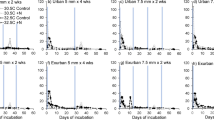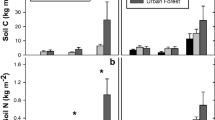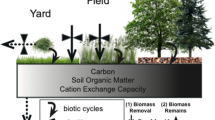Abstract
To examine the impact of projected climate changes on secondary succession, we exposed the same fallow soil with a common seed bank to an in situ gradient of urban to rural macroenvironments that differed in temperature and CO2 concentration ([CO2]). This gradient was established at three locations: Baltimore city center (urban), a city park on the outskirts of Baltimore (suburban), and an organic farm 87 km from the Baltimore city center site (rural). Over a five-year period, the urban site averaged 2.1°C warmer and had a [CO2] that was ~20% higher than at the rural location, indicating that this gradient was a reasonable surrogate for projected changes in those variables for this century. Previous work had demonstrated that other abiotic variables measured across the transect, including tropospheric ozone and nitrogen deposition, did not differ consistently. The first year of exposure resulted in (two- to threefold) greater aboveground biomass in the urban relative to the rural site, but with uniform species composition across sites. Simple regression of abiotic variables indicated that temperature and vapor pressure deficit (VPD) were the best predictors of plant biomass among locations. Stepwise multiple regressions were also performed to analyze the effect of more than one macroenvironmental variable on total plant biomass. The combination of daily CO2 concentration and nighttime temperature explained 87% (P < 0.01) of the variability in total biomass between sites. After five years, the species demography of the plant communities had changed significantly, with a greater ratio of perennials to annuals for the urban relative to the rural location. Greater first-year biomass and litter accumulation at the urban site may have suppressed the subsequent seed germination of annual species, accelerating changes in species composition. If urban macroenvironments reflect future global change conditions, these data suggest a faster rate of secondary succession in a warmer, higher [CO2] world.




Similar content being viewed by others
References
Ainsworth EA, Long SP (2005) What have we learned from 15 years of free-air CO2 enrichment (FACE)? A meta-analytic review of the responses of photosynthesis, canopy properties and plant production to rising CO2. New Phytol 165:351–372
Anderson MJ (2001) A new method for non-parametric multivariate analysis of variance. Austral Ecol 26:32–46
Anderson MJ (2005) PERMANOVA: a FORTRAN computer program for permutational multivariate analysis of variance. Department of Statistics, University of Auckland, Auckland
Bazzaz FA (1996) Plants in changing environments: linking physiological, population and community ecology. Cambridge University Press, Cambridge
Bazzaz FA, Carlson RW (1984) The response of plants to elevated CO2, I. Competition among an assemblage of annuals at two levels of soil moisture. Oecologia 62:196–198
Belote RT, Weltzin JF, Norby RJ (2003) Response of an understory plant community to elevated [CO2] depends on differential responses of dominant invasive species and is mediated by soil water availability. New Phytol 161:827–835
Berry RD, Colls JJ (1990) Atmospheric carbon dioxide and sulphur dioxide on an urban/rural transect. I. Continuous measurements at the transect ends. Atmos Environ 24:2681–2688
Brazel A, Selover N, Vose R, Heisler G (2000) The tale of two climates—Baltimore and Phoenix urban LTER sites. Clim Res 15:123–135
Day TA, Gober P, Xiong FS, Wentz EA (2002) Temporal patterns in near-surface CO2 concentrations over contrasting vegetation types in the Phoenix metropolitan area. Agric For Meteorol 110:229–245
Dufrene M, Legendre P (1997) Species assemblages and indicator species: the need for a flexible asymmetrical approach. Ecol Monogr 67:345–366
Forcella FT (1992) Prediction of weed seedling densities from buried seed reserves. Weed Res 32:29–38
Frank DA, McNaughton SJ (1991) Stability increases with diversity in plant communities: empirical evidence from the 1988 Yellowstone drought. Oikos 62:360–362
George K, Ziska LH, Bunce JA, Quebedeaux B (2007) Elevated atmospheric CO2 and temperature across an urban–rural transect. Atmos Environ 41:7654–7665
Gleeson SK, Tilman D (1990) Allocation and the transient dynamics of succession on poor soils. Ecology 71:1144–1155
Gregg JW, Jones CG, Dawson TE (2003) Urbanization effects on tree growth in the vicinity of New York City. Nature 424:183–187
Hector A, Schmid B, Beierkuhnlein C, Caldeira MC, Diemer M, Dimitrakopoulos PG, Finn JA, Freitas H, Giller PS, Good J, Harris R, Högberg P, Huss-Danell K, Joshi J, Jumpponen A, Körner C, Leadley PW, Loreau M, Minns A, Mulder CPH, O’Donovan G, Otway SJ, Pereira JS, Prinz A, Read DJ, Scherer-Lorenzen M, Schulze E-D, Siamantziouras A-SD, Spehn EM, Terry AC, Troumbis AY, Woodward FI, Yachi S, Lawton JH (1999) Plant diversity and productivity experiments in European grasslands. Science 286:1123–1127
Idso CD, Idso SB, Balling RC Jr (2001) An intensive two-week study of an urban CO2 dome in Phoenix, Arizona, USA. Atmos Environ 35:995–1000
Imhoff ML, Bounoua L, DeFries R, Lawrence WT, Stutzer D, Tucker CJ, Ricketts T (2004) The consequences of urban land transformation on net primary productivity in the United States. Remote Sens Environ 89:434–443
IPCC (2007) Summary for policymakers. In: Solomon S, Qin D, Manning M, Chen Z, Marquis M, Averyt KB, Tignor M, Miller HL (eds) Climate change 2007: the physical science basis (contribution of Working Group I to the Fourth Assessment Report of the Intergovernmental Panel on Climate Change). Cambridge University Press, Cambridge
Klironomos JN, Allen MF, Rillig MC, Piotrowski J, Makvandi-Nejad S, Wolfe BE, Powell JR (2005) Abrupt rise in atmospheric CO2 overestimates community response in a model plant–soil system. Nature 433:621–624
Körner C (1996) The response of complex multispecies systems to elevated CO2. In: Walker BH, Steffen W (eds) Global change and terrestrial ecosystems. Cambridge University Press, Cambridge
Krebs CJ (1985) Ecology: the experimental analysis of distribution and abundance, 3rd edn. Harper and Row, New York
Legendre P, Anderson MJ (1999) Distance-based redundancy analysis: testing multispecies responses in multifactorial ecological experiments. Ecol Monogr 69:1–24
Magurran AE (1988) Ecological diversity and its measurement. Cambridge University Press, Cambridge
Margalef R (1963) On certain unifying principles in ecology. Am Nat 897:357–374
McArdle BH, Anderson MJ (2001) Fitting multivariate models to community data: a comment on distance-based redundancy analysis. Ecology 82:290–297
McCune B, Mefford MJ (2006) PC-ORD for Windows: multivariate analysis of ecological data. MjM Software, Gleneden Beach
McDonnell MJ, Pickett STA, Pouyat RV (1993) The application of the ecological gradient paradigm to the study of urban effects. In: McDonnell MJ, Pickett STA (eds) Humans as components of ecosystems: the ecology of subtle human effects and populated areas. Springer-Verlag, New York, p 189
Morgan JA, Milchunas DG, Le Cain DR, West M, Mosier AR (2007) Carbon dioxide enrichment alters plant community structure and accelerates shrub growth in the shortgrass steppe. Proc Natl Acad Sci USA 104:14724–14729
Naeem S, Thompson LJ, Lawler SP, Lawton JH, Woodfin RM (1994) Declining biodiversity can alter the performance of ecosytems. Nature 368:734–737
Niklaus PA, Leadley PW, Schmid B, Korner C (2001) A long-term field study on biodiversity × elevated CO2 interactions in grassland. Ecol Monogr 71:341–356
Odum EP (1969) The strategy of ecosystem development. Science 164:262–270
Owensby CE, Coyne PE, Ham JM, Auen LM, Knapp AK (1993) Biomass production in a tallgrass prairie ecosystem exposed to ambient and elevated CO2. Ecol Appl 3:644–653
Pataki DE, Xu T, Luo YQ, Ehleringer JR (2007) Inferring biogenic and anthropogenic carbon dioxide sources across an urban to rural gradient. Oecologia 152:307–322
Pickett STA, Cadenasso ML, Grove JM, Nilon CH, Pouyat RV, Zipperer WC, Costanza R (2001) Urban ecological systems: linking terrestrial ecological, physical and socioeconomic components of metropolitan areas. Ann Rev Ecol Syst 32:127–157
Polley HW, Johnson HBJ, Derner JD (2003) Increasing CO2 from subambient to superambient concentrations alters species composition and increases above-ground biomass in a C3/C4 grassland. New Phytol 160:319–327
Poorter H, Navas ML (2003) Plant growth and competition at elevated CO2: on winners, losers and functional groups. New Phytol 157:175–198
Potvin C, Vasseur L (1997) Long-term CO2 enrichment of a pasture community: species richness, dominance, and succession. Ecology 78:666–677
Quinn GP, Keough MJ (2002) Experimental design and data analysis for biologists. Cambridge University Press, Cambridge
Reich PB, Knos J, Tilman D, Craine J, Ellsworth D, Tjoelker M, Lee T, Wedin D, Naeem S, Bahauddin D, Hendrey G, Jose S, Wrage K, Goth J, Bengston W (2001) Plant diversity enhances ecosystem responses to elevated CO2 and nitrogen deposition. Nature 410:809–810
Shaw RM, Zavaleta ES, Chiariello NR, Cleland EE, Mooney HA, Field CB (2002) Grassland responses to global environment changes suppressed by elevated CO2. Science 298:1987–1990
Tilman D (1987) Secondary succession and the pattern of plant dominance along experimental nitrogen gradients. Ecol Monogr 57:189–241
Tilman D (1990) Constraints and tradeoffs: toward a predictive theory of competition and succession. Oikos 58:3–15
Tilman D, Wedin D, Knops J (1996) Productivity and sustainability influenced by biodiversity in grassland ecosystems. Nature 379:718–720
Tilman D, Reich PB, Knops JMH (2006) Biodiversity and ecosystem stability in a decade-long grassland experiment. Nature 441:629–632
Vasseur L, Potvin C (1998) Natural pasture community response to enriched carbon dioxide atmosphere. Plant Ecol 135:31–41
Ziska LH, Bunce JA (2007) Predicting the impact of changing CO2 on crop yields: some thoughts on food. New Phytol 175:607–618
Ziska LH, Bunce JA, Goins EW (2004) Characterization of an urban–rural CO2/temperature gradient and associated changes in initial plant productivity during secondary succession. Oecologia 139:454–458
Acknowledgments
This research was supported by the Biological and Environmental Research Program (BER), US Department of Energy, Interagency Agreement No. DE-AI02-02ER63360 to LHZ, JAB, JLH, and JRT. The authors would like to thank Mr. Ernie Goins, Mr. Jon Clark, Ms. Danielle Reed and Ms. Ruth Mangum for expert technical assistance. The experiments comply with the current laws of the United States.
Author information
Authors and Affiliations
Corresponding author
Additional information
Communicated by Louis Pitelka.
Rights and permissions
About this article
Cite this article
George, K., Ziska, L.H., Bunce, J.A. et al. Macroclimate associated with urbanization increases the rate of secondary succession from fallow soil. Oecologia 159, 637–647 (2009). https://doi.org/10.1007/s00442-008-1238-0
Received:
Accepted:
Published:
Issue Date:
DOI: https://doi.org/10.1007/s00442-008-1238-0




